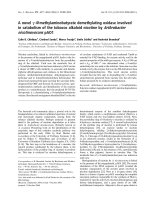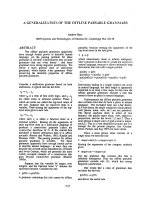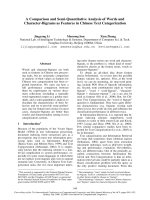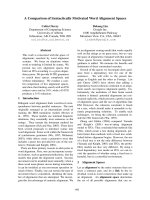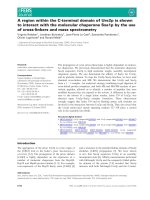báo cáo khoa học: "A comparison of the level of enzyme polymorphism in cosmopolitan Drosophila species between populations collected in distilleries and in their surroundings in Hungary" ppt
Bạn đang xem bản rút gọn của tài liệu. Xem và tải ngay bản đầy đủ của tài liệu tại đây (433.14 KB, 11 trang )
Original
article
A
comparison
of
the
level
of
enzyme
polymorphism
in
cosmopolitan
Drosophila
species
between
populations
collected
in
distilleries
and
in
their
surroundings
in
Hungary
K. Pecsenye
Kossuth
Lajos
University,
Department
of Zoology
and
Anthropology,
Debrecen
f 0,
PO
Box
3,
H-4010
Hungary
(received
4
September
1987,
accepted
1
September
1988)
Summary —
The
level
of
enzyme
polymorphism
was
studied
in
populations
of
Drosophila
melano-
gaster and
D.
hydei from
three
different
regions
of
Hungary.
Collections
were
made
in
distilleries
or
by
outside
baits.
Allozyme
variability
was
investigated
for
five
loci
(Adh,
Odh;
Mdh;
a-Gpdh;
a Amy)
by
means
of
polyacrylamide
gel
electrophoresis.
Two
different
rare
alleles
were
detected
for
the
Adh
locus
in
D.
hydei
in
Hungary.
The
number
of
species
was
lower
in
distilleries
than
outside.
The
heterozygosity
level
in
samples
from
distilleries
was
generally
lower
than
in
samples
from
outside.
This
result
gives
support
to
the
hypothesis
that
the
more
diverse
the
environment
the
higher
the
level
of
polymorphism
maintained.
enzyme
polymorphism -
distillery -
Drosophila
hydel
Résumé —
Comparaison
du
polymorphisme
enzymatique
chez
des
espèces
cosmopolites
de
drosophiles,
entre
des
populations
Hongroises
échantillonnées
dans
des
distilleries
et
dans
les
environs.
Le
polymorphisme
enzymatique
a
été
étudié
dans
des
populations
de
Drosophila
melanogaster
et
de
D.
hydei
issues
de
trois
régions
de
Hongrie.
Les
récoltes
ont
été
réalisées
dans
des
distilleries
et
à
l’extérieur
par
piégeage.
La
variabilité
des
allozymes
a
été
étudiée
en
cinq
locus
(Adh;
Odh; Mdh;
a-Gpdh;
a-Amy)
par
électrophorèse
sur
gel
de
polyaailamide.
Deux
allèles
rares
ont
été
détectées
au
locus
Adh
dans
les
populations
hongroises
de
D.
hydei.
Le
nombre
d’espèces
est plus
petit
dans
les
distilleries
qu’à
l’extérieur.
Le
niveau
d’hétérozygotie
est
en
général
plus
bas
dans
les
échantillons
prélevés
dans
les
distilleries
qu’à
l’extérieur.
Ce
résultat
renforce
l’hypothèse
que
le
polymorphisme
est
maintenu
à
un
niveau
d’autant
plus
élevé
que
le
milieu
est plus
variable.
polymorphisme
enzymatique -
distillerie -
Drosophila
melanogaster -
Drosophila
hydei
Introduction
Genetic
differentiation
within
a
species
is
a
common
response
to
environmental
hetero-
geneity.
Some
of
the
existing
field
studies
indicate
association
between
the
level
of
poly-
morphism
at
several
enzyme
loci
and
the
geographical
variation
of
different
environmen-
tal
factors
(Nevo,
1978;
Triantaphyllidis
et al.,
1980;
Oakeshott
et al.,
1982;
Singh
et al.,
1982;
Van
Delden,
1982;
Oakeshott
et al.,
1983;
Nevo
et al.,
1984).
Many
authors
have
studied
microdifferentiation
of
Drosophila
populations
living
in
wine
cellars
and
in
the
surroundings
(McKenzie
and
Parsons,
1974;
Briscoe
et al.,
1975;
McKenzie
and
McKenzie,
1978;
Parsons,
1980;
McKenzie
and
McKenzie,
1983).
Their
main
interest
was
the
gene
frequency
distribution
at
the
Adh
locus
in
populations
from
the
2
types
of
micro-habitats.
It
would
also
be
interesting,
however,
to
study
the
differ-
ence
in
the
genetic
diversity
of
the
2
kinds
of
populations.
In
the
case
of
laboratory
popu-
lations,
several
observations
have
revealed
differences
in
the
average
frequency
of
hete-
rozygotes
when
Drosophilids
were
kept
in
homogeneous
and
heterogeneous
environ-
ments
(Powell,
1971;
McDonald
and
Ayala,
1974;
Hale
and
Birley,
1983).
This
study
provides
data
for
a
comparison
of
the
level
of
polymorphism
at
4
enzyme
loci
among
village
populations
of
Drosophila
melanogaster
and
D.
hydei,
and
those
living
in
distilleries.
We
have
found
that
the
average
frequency
of
heterozygotes
is
higher
in
the
village
populations
at
the
investigated
loci.
Materials
and
Methods
Drosophilids
were
collected
in
3
large
regions
of
Hungary:
the
Central
Tisza
region
(region
I),
the
Bereg
plain
(region
II)
and
the
Sajo
and
Hernad
valley
(region
111).
Signs
on
the
map
(Fig.
1)
show
the
distilleries
where
collection
took
place.
Enzyme
polymorphism
was
determined
from
13
samples
with
high
individual
counts
of
both
D.
melanogaster
and
D.
hydei
(full
circles).
In
order
to
obtain
field
populations
we
used
normal
maize-
sucrose
media
as
baits
in
the
farmyards
of
the
villages
close
to
these
distilleries.
Similar-
ly
to
the
fermenting
mash
in
the
distilleries,
this
bait
attracted
the
flies
so
we
were
able
to
collect
them
easily
in
the
surroundings.
A
glass
suction
tube
was
used
for
the
collection
in
both
micro-habitats.
Four
or
5
loci -
alcohol
dehydrogenase
(Adh),
octanol
dehydrogenase
(Odh),
malate
dehydrogenase
(Mdh),
a!lycerophosphate
dehydrogenase
(a!pdh)
and
a-amylase
(a Amy) -
were
examined
in
each
sample.
Electrophoresis
was
conducted
on
vertical
polyacrylamide
slabs
using
a
discontinuous
buffer
system
(O’Brien,
1973;
Doane
et
al.,
1975;
Clark,
1983;
Winberg
ef al.,
1983;
Batterham
et al.,
1984).
Genotype
and
allele
frequencies
were
then
calculated.
Statistical
procedures
Standard
errors
of
heterozygosity
were
calculated
on
a
Commodore
64
computer
by
means
of
the
Number
Cruncher
1
programme.
As
the
proportion
of
heterozygotes
was
close
to
zero
for
most
of
the
investigated
loci,
we
used
the
angular
transformation
of
frequency
data
when
the
t-tests
were
calculated.
A
paired
t test
was
performed
on
a
Commodore
64
computer
using
the
Number
Crun-
cher
1
programme.
Results
The
common
species
in
distilleries
were
D.
melanogaster and
D.
hydei.
Some
individuals
of
other
species
also
appeared,
such
as
D.
immigrans,
D.
funebris
and
D.
busckii.
The
bait
in
the
villages,
however,
attracted
more
species:
besides
the
2
common
ones,
we
collected
quite
large
samples
of
D.
immigrans
in
each
location
and
some
samples
of
D. funebris
and
D.
busckii
in
region
I.
Other
species
such
as
D.
repleta.,
D.
obscura
and
D.
subobscura
were
scarce
(Table
1).
The
distribution
of
allele
frequencies
at
the
investigated
loci in
D.
melanogaster
popu-
lations
collected
in
distilleries
and
in
villages
using
baits
is
shown
in
Table
Ila
and
lib,
res-
pectively.
At
the
Adh
locus,
almost
all
the
populations
were
polymorphic;
however,
the
frequency
of
the
slow
allele
was
rather
low.
This
is
in
good
agreement
with
the
European
frequency
gradient
(Oakeshott
et al.,
1982).
The
populations
investigated
were
less
poly-
morphic
at
the
Odh
than
at
the
Adh
locus.
For
the
Mdh
and
a-Amy
loci,
we
found
that
the
frequencies
of
alternative
alleles
were
also
rather
low.
As
the
a-amylase
enzyme
is
enco-
ded
by
a
duplicated
locus
we
did
not
calculate
allele
frequencies,
thus
only
the
phenoty-
pe
frequencies
are
presented
in
the
tables
(Doane
et al.,
1975;
Singh
et al.,
1982).
At
the
a-Gpdh
locus
the
average
frequencies
of
the
slow
allele
were
0.291
for
the
populations
originating
from
distilleries
and
0.265
for
those
collected
in
villages.
On
the
basis
of
the
results
of a x
2
test
we
concluded
that
all
the
populations
at
all
the
investigated
loci
were
in
Hardy-Weinberg
equilibrium.
Drosophila
hydei
was
the other
cosmopolitan
species
in
our
study.
As
opposed
to
D .
melanogaster,
this
species
did
not
occur
in
large
masses
either
in
distilleries
or
on
bait.
The
allele
frequency
values
at
all
the
investigated
loci in
D.
hydei
populations
collec-
ted
in
distilleries
and
in
villages
by
baits
are
presented
in
Table
Illa
and
Illb,
respectively.
The
Adh
locus
is
known
to
be
monomorphic
in
populations
of
D.
hydei
in
the
United
States
(Batterham
et
al.,
1984).
In
some
of
the
collecting
sites,
however,
we
found
2
dif-
ferent
rare
alleles
at
this
locus.
Figure
2
shows
the
new
genotypes.
The
F
allele
was
the
most
common,
and
the
rare
alleles
showed
either
faster
or
slower
migration.
These
rare
alleles
appeared
only
in
a
few
populations,
mostly
in
region
I.
At
the
Mdh
locus
3
alleles,
i.e.
6
genotypes,
appeared
in
Hungarian
populations.
Allele
S*
was
found
only
in
popula-
tions
collected
on
baits,
and
the
frequency
of
allele
F
was
slightly
higher
in
these
popula-
tions.
The
a-Gpdh
locus
was
actually
monomorphic
with
rare
alleles
appearing
mainly
in
region
II.
Similarly
to
the
Adh,
the
a Amy
locus
had
2
rare
alleles
(Doane
et
al.,
1975)
that
were
mainly
found
in
populations
of
region
111.
Discussion
We
compared
the
level
of
polymorphism
in
populations
originating
from
distilleries
to
those
collected
in
villages
in
the
case
of
both
species.
Some
important
data -
as
a
basis
of
comparison -
are
presented
in
Table
IV
for
D.
melanogaster
populations.
All
3
of
the
parameters -
proportion
of
polymorphic
populations
(frequency
of
rare
alleles >
0.01),
average
number
of
alleles
(each
investigated
allele
taken
into
account)
and
average
heterozygosity -
indicate
a
higher
level
of
polymorphism
in
the
field
as
compared
with
the
distillery
populations
at
4
of
the
investigated
loci.
In
D.
melanogaster the
highly
poly-
morphic
a!pdh
locus
was,
however,
an
exception.
In
the
case
of
D.
hydei
populations,
Table
V
shows
the
most
basic
data
for
compari-
son.
The
3
examined
parameters
show
the
level
of
polymorphism
to
be
higher
in
village
populations
for
3
of
the
investigated
loci.
The
only
exception
was
the
highly
polymorphic
Mdh
locus.
As
the
average
frequencies
of
heterozygotes
have
rather
high
standard
errors,
we
tested the
statistical
significance
of
differences
between
populations
originating
from
the
2
habitats,
villages
versus
distilleries.
Results
of
the
t-test
are
shown
in
Table
Vi.
The
dif-
ferences
approached
significance
or
were
significant
at
all
the
investigated
loci
except
a-Gpdh
in
D.
melanogaster
and
Mdh
in
D.
hydei;
i.e.,
genic
diversity
appears
higher
in
the
villages
as
compared
with
the
distilleries.
It
can
be
concluded
that
field
populations
had
a
higher
level
of
enzyme
polymorphism
in
comparison
with
those
living
in
distilleries.
This
tendency
clearly
appears
at
those
enzyme
loci
with
a
low
heterozygosity
level.
A
possible
explanation
for
the
situation
is
that
both
species
develop
in
villages
in
more
diverse
resources,
in
fermenting
windfalls,
in
rotting
vegetables,
in
rubbish,
etc.
In
distilleries,
however,
Drosophilids
grow
in
a
more
uniform
environment,
on
mash
with
rather
high
alcohol
concentrations.
It
is
interesting,
however,
that
the
highly
polymorphic
loci
(D.
melanogaster:
a-Gpdh,
D.
hydei:
Mdh)
do
not
show
such
a
difference.
Environments
in
nature
are
usually
heterogeneous
in
time
and
space -
the
environ-
ment
of
the
population
has
a
grain
structure.
A
fine
grain
would
make
polymorphism
less
likely
to
be
achieved,
or
would
reduce
the
stability
of
polymorphism
already
attained
(Levins
and
Macartur,
1966).
With
coarseness
of
grain,
however,
the
population
may
maintain
some
choice
of
genotypes
over
the
types
of
conditions
available
(Levins
and
Macartur,
1966;
Gillespie
and
Langley,
1974;
Taylor,
1975).
Our
results
support
the
hypo-
thesis
that
the
more
diverse
the
environment,
the
higher
the
level
of
polymorphism
that
can
be
maintained
(Powell,
1971;
McDonald
and
Ayala,
1974;
Nevo
et al.,
1984).
Acknowledgments
The
author
is
most
grateful
to
Prof.
Dr.
Z.
Varga
for
his
help
throughout
this
study.
The
technical
assistance
of
Miss
M.
Balogh
and
V.
Mester
is
highly
appreciated.
References
Batterham
P.,
Chambers
G.K.,
Starmer
W.T
&
Sullivan
D.T
(1984)
Origin
and
expression
of
an
alco-
hol
dehydrogenase
gene
duplication
in
the
genus
Drosophila.
Evolution
38, 644-657
Briscoe
D.A.,
Robertson
A.
&
Malpica
J.
(1975)
Dominance
at
Adh
locus
is
response
of
aduft
Dro-
sophila
melanogaster to
environmental
alcohol.
Nature
255,
148-149
Clark
B.A.
(1983)
Cytogenetic
localization
by
variation
in
electrophoretic
allozyme
phenotype:
Dro-
sophila
Odh.
Biochem.
Genet.
21, 375-390
Doane
W.W.,
Abraham
I.,
Kolar
M.M.,
Martenson
R.E.
&
Deibler
G.E.
(1975)
Purified
Drosophila
a-amylase
isozymes:
genetical,
biochemical,
and
molecular
characterization
In:
lsozymes.
IV.
Genetics
and
Evolution
(C.L.
Markert,
ed),
Academic
Press,
New
York,
pp.
585-607
Gillespie
J.H.
&
Langley
C.H.
(1974)
A
general
model
to
account
for
enzyme
variation
in
natural
populations.
Genetics
76, 837-848
Hale
C.S.
&
Birley
A.J.
(1983)
The
genetical
response
to
natural
selection
by
varied
environments.
II.
Observations
on
replicate
populations
in
spatially
varied
laboratory
environments.
Heredity
51,
581-606
Levins
R.
&
Macartur
R.
(1966)
Maintenance
of
genetic
polymorphism
in
a
heterogeneous
environ-
ment:
variations
on a
theme
by
Howard
Levene.
Am.
Nat.100, 585-590
McDonald
J.F.
&
Ayala
F.J.
(1974)
Genetic
response
to
environmental
heterogenity.
Nature
250,
572-574
’
McKechnie
S.W.
&
McKenzie
J.A.
(1983)
Polymorphism
of
alcohol
dehydrogenase
(ADM
in
a
wine-
ry
cellar
population
of
Drosophila
melanogaster :
gene
frequency
association
with
temperature
and
genotypic
differences
in
progeny
production
Evolution
37, 850-853
McKenzie
J.A.
&
McKechnie
S.W.
(1978)
Ethanol
tolerance
and
the
Adh
polymorphism
in
a
natural
population
of
Drosophila
melanogaster.
Nature
272, 75-76
McKenzie
J.A.
&
Parsons
P.A.
(1974)
Microdifferenciation
in
a
natural
population
of
Drosophila
melanogasterto
alcohol
in
the
environment.
Genetics 77,
385-394
Nevo
E.
(1978)
Genetic
variation
in
natural
populations:
patterns
and
theory.
Theor.
Pop.
Biol.
13,
121-177
Nevo
E.,
Belles
A.
&
Ben-Shlomo
R.
(1984)
The
evolutionary
significance
of
genetic
diversity:
ecolo-
gical,
demographic
and
life
history
correlates.
In:
Evolutionary
Dynamics
of
Genetic
Diversity.
(G.S.
Mani,
ed.),
Lecture
Notes
in
Biomathematics
53,
Springer-Verlag,
Berlin,
pp.13-213
3
Oakeshott J.C.,
Gibson
J.B.,
Anderson
P.R.
&
Knibb
W.R.
(1982)
Alcohol
dehydrogenase
and
glyce-
rol-3-phosphate
dehydrogenase
clines
in
Drosophila
melanogaster
on
different
continents.
Evolu-
tion
36,
86-96
Oakeshott
J.G.,
Gibson,
J.B.
&
Willcocks
D.A.
(1983)
Latitudinal
variation
in
octanol
dehydrogenase
and
acid
phosphatase
allele
frequencies
in
Drosophila
melanogaster.
Theor.
Appl.
Genet.
65, 191-
196
O’Brien
S.J.
(1973)
Comparative
analysis
of
malate
dehydrogenase
of
Drosophila
melanogaster.
Biochem.
Genet.
10, 191-205
Parsons
P.A.
(1980)
Responses
of
Drosophila
to
environmental
ethanol
from
ecologically
optimal
and
extreme
habitats.
Experientia
36, 1070-1071
Powell
J.R.
(1971)
Genetic
polymorphism
in
varied
environments.
Science
174, 1035-1036
Singh
R.S.,
Hickey
D.A.
&
David
J.
(1982)
Genetic
differentiation
between
geographically
distant
populations
of
Drosophila
melanogaster.
Genetics
101, 235-256
Taylor
C.E.
(1975)
Genetic
loads
in
heterogeneous
environments.
Genetics
80, 621-635
Triantaphyllidis
C.D.,
Panourgias
J.N.,
Scouras
Z.G.
&
loanuidis
G.C.
(1980)
Comparison
of
gene-
enzyme
variation
between
Drosophila
melanogaster
and
Drosophila
simulans.
Genotica
51,
227-
231
Van
Delden
W.
(1982)
The
alcohol
dehydrogenase
polymorphism
in
Drosophila
melanogaster.
Evol. Biol.
15, 187-222
Winberg
J.,
Thatcher
D.R.
&
McKinley-McKee
J.S.
(1983)
Drosophila
melanogaster
alcohol
dehy-
drogenase:
an
electrophoretic
study
of
the
AdhS,
AdhF and
AdhUF
alloenzymes.
Biochem.
Genet.
21, 63-80

